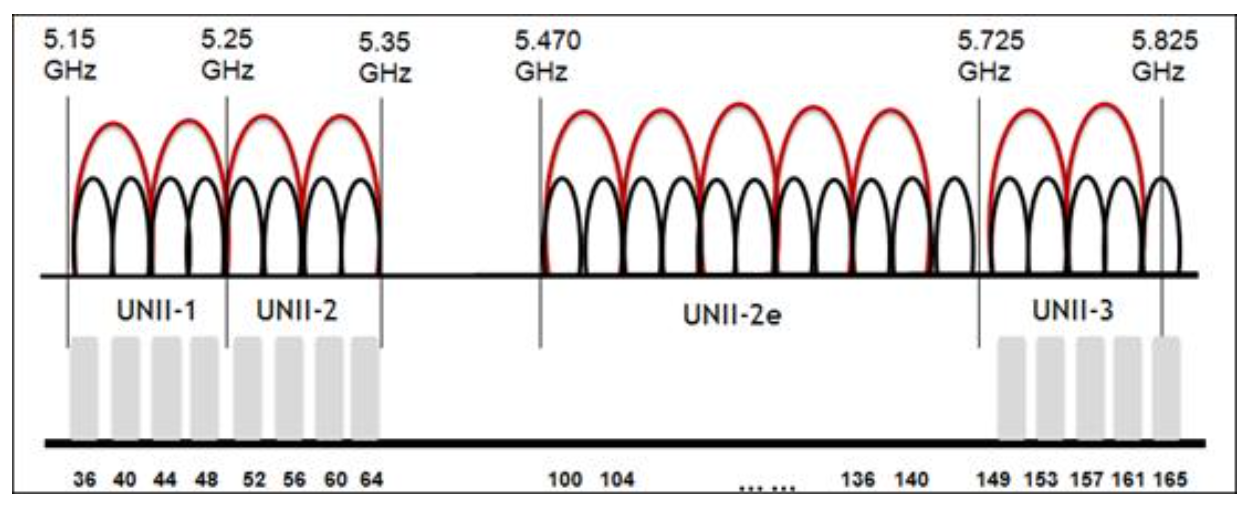As a supplement to the ONT basic knowledge, I began to introduce a series of basic Wi-Fi knowledge.
Today, I will share knowledge about 2.4 GHz Wi-Fi and 5 GHz Wi-Fi.
Many ONTs support dual-band Wi-Fi, that is, 2.4 GHz Wi-Fi and 5 GHz Wi-Fi (corresponding to 2 SSIDs on an ONT nameplate). What is the difference between 2.4 GHz Wi-Fi and 5 GHz Wi-Fi?
Wi-Fi Frequency Band
The most essential difference lies in the operating frequency bands. As described in the following table, the 5 GHz Wi-Fi frequency band has higher frequencies and frequency bandwidths, provides a higher rate, but has lower channel interference.
| Wi-Fi | 2.4 GHz Wi-Fi | 5 GHz Wi-Fi |
| Operating frequency band | 2.4GHz–2.4835 GHz | 5.150–5.350 GHz and 5.725–5.850 GHz |
| Channel bandwidth | Standard: 20 MHz; extended: up to 40 MHz |
Standard: 20 MHz; extended: up to 40/80 MHz or higher |
| Rate | Up to 600 Mbit/s (802.11n, 4×4 MIMO, 40 MHz) |
Up to 1733 Mbit/s (802.11ac, 4×4 MIMO, 80 MHz) |
Wi-Fi Channel
-
2.4 GHz Wi-Fi Channels
According to WLAN standards and protocols, the 2.4 GHz frequency band is divided into 13 overlapping channels. Each channel uses a specific bandwidth (20 MHz for each 802.11g or 802.11n channel, and 22 MHz for each 802.11b channel) and has its own center frequency.
Among the 13 channels, there are 3 independent channels that do not overlap each other. Because the independent channels do not have overlapped frequencies, neighboring APs using the independent channels do not interfere with each other. In the following figure, channels 1, 6, and 11 are independent channels.

-
5 GHz Wi-Fi Channels
According to WLAN standards and protocols, the 5 GHz frequency band is divided into 24 independent channels, each with a bandwidth of 20 MHz. This provides abundant channel resources for WLAN, and more independent channels make channel binding more valuable. Channel binding is to bind two channels into one channel to provide higher bandwidths. For example, two 20 MHz independent channels can be bound together to obtain a 40 MHz throughput, which is similar to combining two roads into one to improve road capacity.
As shown in the following figure, a black semicircle indicates an independent channel, and a red semicircle indicates a bound channel as recommended by the standards and protocols.

Wall Penetration Capability
Compared with 2.4 GHz Wi-Fi, 5 GHz Wi-Fi has a weaker wall penetration capability, which is determined by the physical characteristics of electromagnetic waves. That is, a longer wavelength has less attenuation and is easier to pass through obstacles for further transmission.
5 GHz signals are at higher frequencies and shorter wavelengths. Therefore 5 GHz signals cause larger attenuation when passing through obstacles and have a weaker wall penetration capability.
Advantages and Disadvantages
| Wi-Fi | 2.4 GHz Wi-Fi | 5 GHz Wi-Fi |
| Advantages | During transmission in the air or through obstacles, the attenuation is small and the reach is long. |
The rate is high and the interference is small. |
| Disadvantages | The 2.4 GHz frequency band is narrow and crowded. It is used by most home appliances and wireless devices. In addition, the interference is large. |
During transmission in the air or through obstacles, the attenuation is large, and the coverage distance is shorter than that of 2.4 GHz signals. |
Selection of a Wi-Fi Frequency Band
2.4 GHz and 5 GHz Wi-Fi have different advantages and disadvantages. You can select an optimal frequency band based on the actual environment. Static devices such as web TVs and laptops can use a faster frequency band between 2.4 GHz and 5 GHz, while mobile terminals such as mobile phones and tablets can use different frequency bands in different locations as required.
In addition, when being weaker than 2.4 GHz signals, 5 GHz signals are not necessarily slower than 2.4 GHz signals. The network speed is related to both signal strength and channel quality.
After passing through a wall, 2.4 GHz Wi-Fi may show 3 bars of signals, while 5 GHz Wi-Fi may show only 2 bars of signals. If the surrounding wireless interference is too large, the 2.4G Wi-Fi that provides 3 bars of signals may buffer the video frequently, while the 5G Wi-Fi that provides 2 bars of signals can play back the video smoothly. In this sense, 5 GHz Wi-Fi is more suitable for applications that require a high network speed and low latency, such as downloads, voice services, and real-time games.



Leave a comment